Barbara Kruger This Masterpiece Is Just Barbara Kruger Popular Art
/https://tf-cmsv2-smithsonianmag-media.s3.amazonaws.com/filer/Profile-Barbara-Kruger-631.jpg)
Barbara Kruger is heading to Washington begetting the single word that has the ability to milk shake the seat of authorities to its roots and carve its sclerotic, deep-frozen deadlock.
What is the word? Well, offset let me introduce Barbara Kruger. If y'all don't know her proper name, y'all've probably seen her work in art galleries, on magazine covers or in giant installations that comprehend walls, billboards, buildings, buses, trains and tram lines all over the world. Her new installation at the Hirshhorn Museum in Washington, D.C., scheduled to open August 20—the one that focuses on that powerful, power-zapping word (yeah, I volition tell you what it is)—volition be visible from 2 floors of public space, filling the entire lower lobby area, too covering the sides and undersides of the escalators. And when I say floors, I hateful that literally. Visitors will walk upon her words, exist surrounded by walls of her words, ride on escalators covered with her words.
What's the best mode to draw her work? You know abstract expressionism, right? Well, think of Kruger's art equally "excerpt expressionism." She takes images from the mass media and pastes words over them, big, bold extracts of text—aphorisms, questions, slogans. Curt motorcar-gun bursts of words that when isolated, and framed past Kruger'south gaze, linger in your listen, forcing yous to call up twice, thrice nearly clichés and catchphrases, introducing ironies into cultural idioms and the conventional wisdom they embed in our brains.
A woman's face in a mirror shattered past a bullet hole, a mirror on which the phrase "Y'all are not yourself" is superimposed to destabilize united states of america, at least momentarily. (Not myself! Who am I?) Her aphorisms range from the overtly political (Your body is a battleground) to the culturally acidic (Charisma is the perfume of your gods) to the challengingly metaphysical (Who do you lot think you are?).
Kruger grew upwards centre class in Newark, New Jersey, and her first job was every bit a page designer at Mademoiselle. She turned out to exist a master at using type seductively to frame and foreground the image and lure the reader to the text.
The dream-machine magazine empire of Condé Nast (which likewise publishes Vogue, Vanity Fair and Glamour)—the dizzyingly seductive and powerful fusion of way, class, money, image and status—represented both an inspiration and an inviting target. The fantasy-fueled appetite to consume became Kruger'due south indelible subject when she left for the downtown fine art world, where many of her early on pieces were formal verbal defacements of glossy magazine pages, glamorous graffiti. One of her well-nigh famous works proclaimed, "I store therefore I am."
Kruger keeps her finger tightly pressed to the pulse of popular civilization. So it shouldn't have surprised me as much equally it did when, in the middle of a recent lunch at the Los Angeles County Museum of Art, she practically leapt out of her chair and pointed excitedly to someone on the plaza outside. "It's the barber from Bravo!" she exclaimed excitedly. When I professed ignorance, Kruger explained, "She's on this Bravo reality series where she goes into failing pilus salons and fixes them upwards." (I later learned the woman was Tabatha, from a show chosen "Tabatha Takes Over.")
In add-on to being a self-proclaimed "news junkie" and bookmarking the Guardian and other such serious sites, Kruger is a large student of reality shows, she told me. Which makes sense in a way: Her work is all about skewed representations of reality. How we pose as ourselves. She discoursed knowingly nigh electric current trends in reality shows, including the "preppers" (preparing for the apocalypse) and the storage wars and the hoarder shows. Those shows, she thinks, tell us of import things most value, materialism and consumerism.
Kruger has immersed herself in such abstract thinkers equally Walter Benjamin, the prewar post-modernist ("Did you know he was a compulsive shopper? Read his Moscow Diary!"), and Pierre Bourdieu, the influential postmodern French intellectual responsible for the concept of "cultural capital" (the thought that status, "prestige" and media recognition count as much as money when it comes to assessing power). Just she knows theory is not enough. She needs to wade into the dirty river of American civilization, panning for iconic words and images like a miner looking for gold in a fast-running stream, extracting the nuggets and giving them a setting and a shine so they can serve as our mirror.
Christopher Ricks, a former Oxford professor of poetry, once told me the simplest manner to recognize value in fine art: It is "that which continues to repay attention." And Barbara Kruger's words not only repay simply demand attention from u.s.. Her piece of work has get more relevant than ever at a fourth dimension when we are inundated by words in a dizzying, delirious way—by the torrent, the tidal moving ridge, the tsunami unleashed by the Internet. "What do you lot read, my lord?" Polonius asks Village. "Words, words, words," he replies. Meaningless words. And that is what they threaten to become every bit we drown in oceans of text on the spider web. Pixels, pixels, pixels.
In a virtual world, virtual words are becoming most weightless, dematerialized. The more words wash over u.s.a., the less nosotros understand them. And the less we are able to recognize which ones are influencing united states—manipulating united states subtly, invisibly, insidiously. Barbara Kruger rematerializes words, then that we tin can read them closely, deeply.
I arrived early for our lunch at LACMA because I wanted to run into the installation she'd done there, covering a massive three-story glassed-in garage elevator with an extraordinary profusion of words and phrases. Among these words and phrases is a long, eloquent description of the work itself:
"The work is about...audition and the scrutiny of judgment...fashion and the imperialism of garments, customs and the discourse of self-esteem, witnessing and the all-powerful moment, spectacle and the enveloped viewer, narrative and the gathering of incidents, simultaneity and the elusive now, digitals and the rush of the capture." There's much, much more just in case we miss whatever aspect of what "the work is about." Indeed the work is in part about a piece of work telling itself what information technology's about.
Notice how much of it is near extraction: extraction of "the all-powerful moment" from the stream of fourth dimension (and stream of consciousness), finding a way to crystallize the "elusive now" amid the rush of "digitals." It's the Kruger of all Krugers.
Merely gazing at this, I missed the single nearly important extraction—or at least its origin. The elephant in the installation.
It was up in that location, dominating the height of the work, a line written in the biggest, boldest, baddest messages. The central stack of words is superimposed over the brooding eyes and the advancing shoes of a man in what looks like a black-and-white movie notwithstanding. His head is exploding into what looks like a bare white mushroom cloud, and on the cloud is written: "If you want a film of the future, imagine a boot stomping on a human face forever."
Take a nice twenty-four hour period, museumgoers!
Not long afterward, I was seated in LACMA'southward sleek restaurant with Kruger, whose waterfalls of delicate curls requite her a pre-Raphaelite, Laurel Canyon wait. (She lives half the twelvemonth in L.A. teaching at UCLA, half the yr in New York City.) One of the start things I asked about was that boot-stomping line on the elevator installation. "I was glad to see someone every bit pessimistic as me about the futurity. Where'd you become that quote?"
"It's George Orwell," she replied. Orwell, of form! It'southward been a long time since I've read 1984, and so I'g grateful that she extracted information technology, this unmediated prophecy of doom from someone whose pronouncements have, uncannily and tragically, kept coming true. And information technology reminded me that she shares with Orwell an oracular way of thought—and a preoccupation with language. Orwell invented Newspeak, words refashioned to become lies. Kruger works similarly, but in the reverse direction. Truespeak? Kru-speak?
"Unfortunately," she went on to remark ominously of the Orwell quote, "it's still very viable."
For some, Kruger has had a forbidding aura, which is probably because of the stringent feminist content of some of her more agitprop aphorisms, such as "Your body is a battleground," which features a woman's face made into a grotesque-looking mask by slicing it in half and rendering i side as a negative. When I after told people I'd institute Kruger downwards-to-earth, humorous and even kindly, those who knew her readily agreed, those who knew simply her early work were a bit surprised.
But she's made a point of existence more than an ideologue. "I always say I try to make my work virtually how we are to one some other," she told me.
That reminded me of ane of her works in which the word "empathy" stood out.
"'How we are to each other,'" I asked. "Is that how you ascertain empathy?"
"Oh," she replied with a laugh, "well, too oftentimes it's not [how we are to each other]."
"Just ideally...nosotros're compassionate?"
"No," she said, "I don't know if that'due south been wired into us. Just I mean I've never been engaged with the state of war of the sexes. It'due south too binary. The good versus the bad. Who'southward the good?"
It's a phrase she uses often: "too binary." She'd rather work in multiple shades of meaning and the ironies that undercut them.
All of which brings us to her upcoming installation invasion of Washington and that potent, verboten word she wants to bring to Washington's attending. The magic word with the hush-hush power that is like garlic to Dracula in a town full of partisans. The word is "Dubiety."
"I'd only been in Washington a few times, mainly for antiwar marches and pro-choice rallies," she said. "Just I'm interested in notions of power and control and beloved and coin and death and pleasure and pain. And Richard [Koshalek, the director of the Hirshhorn] wanted me to exercise candor without trying to be ridiculously...I think I sometimes come across things that are provocative for provocations' sake." (A rare admission for an artist—self-doubt.) "So I'1000 looking forward to bringing upwardly these problems of belief, power and doubt."
The official championship she'due south given her installation is Belief+Doubt. In an earlier work (pictured beneath), she had used the phrase Belief+Uncertainty=Sanity.
I asked her what had happened to "sanity." Had she given up on it?
"You tin can say 'clarity,' you can say 'wisdom,'" she replied, but if yous expect at the equation closely, adding uncertainty to conventionalities is actually subtracting something from belief: blind certainty.
The conversation about incertitude turned to agnosticism, the ultimate doubt.
She made clear there's an important distinction betwixt being an atheist and being an agnostic, as she is: Atheists don't doubt! "Atheists accept the ferociousness of true believers—which sort of undermines their position!" she said.
"In this country," she added, "it's easier to be a pedophile than an doubter."
Both sides—believer and atheist—depend on certainty to hold themselves together. A dynamic that also might explicate the deadlock in politics in Washington: both sides refusing to acknowledge the slightest doubtfulness almost their position, about their values, about the claim to have all the answers.
"Whose values?" is the Kruger extraction at the very summit of her Hirshhorn installation—and its most subversive question. With the absence of doubtfulness, each side clings to its values, devaluing the other side'due south values, making any cooperation an act of betrayal.
"Everybody makes this values claim," she pointed out, "that their values are the only values. Doubt is nigh grounds for arrest—and we're however perilously close to that in many means, y'all know."
And and so in its fashion the Hirshhorn installation may turn out to be genuinely subversive. Introducing doubt into polarized D.C. political civilisation could exist like letting loose a mutation of the swine flu virus.
Let's hope information technology's contagious.
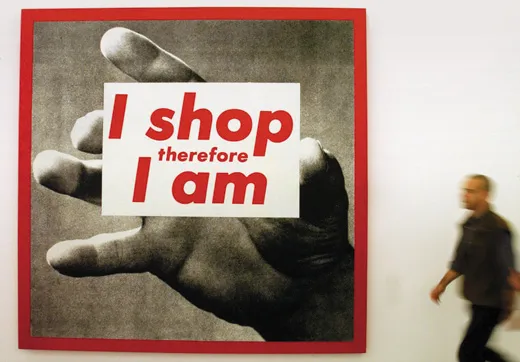
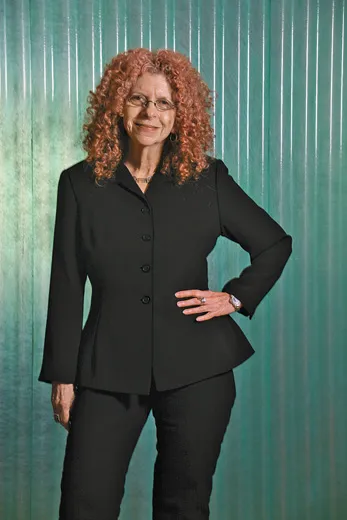
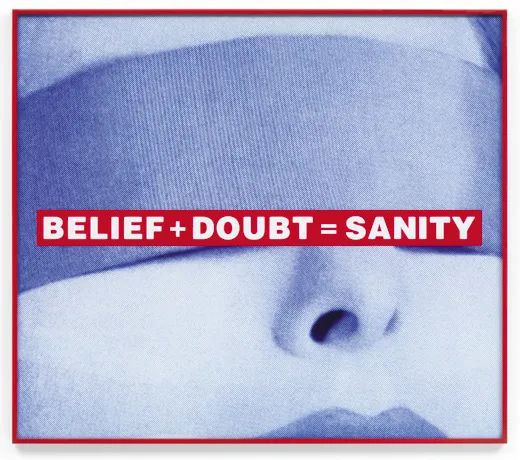
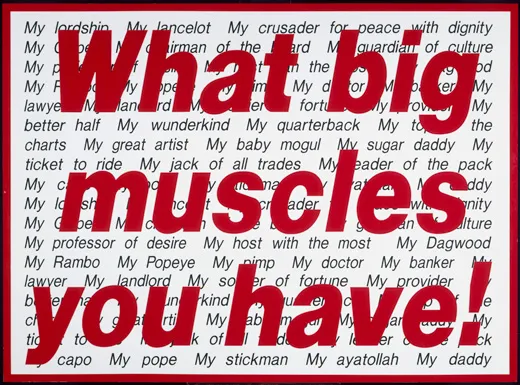
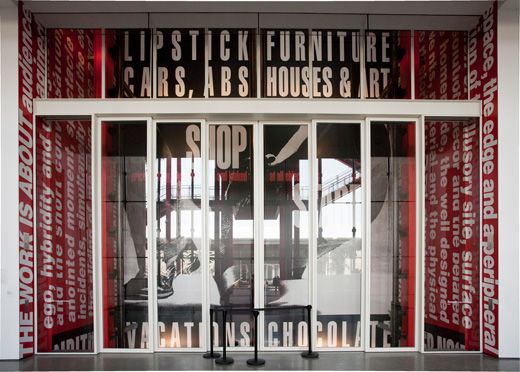
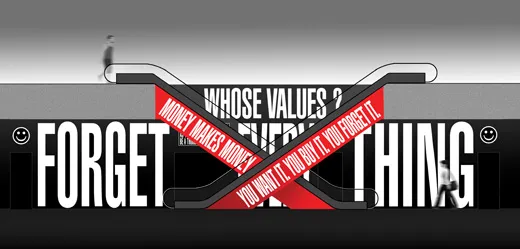
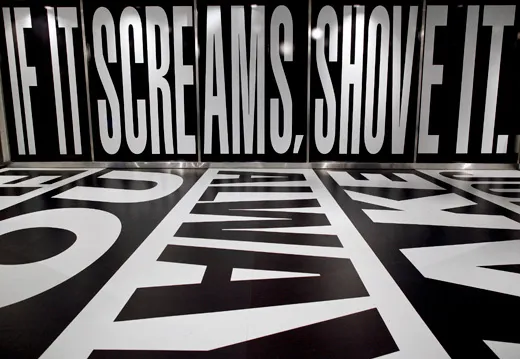

0 Response to "Barbara Kruger This Masterpiece Is Just Barbara Kruger Popular Art"
Post a Comment